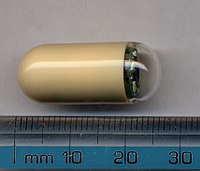
Photo from wikipedia
Artificial intelligence (AI) has revolutionized the diagnosis of gastrointestinal endoscopy, including capsule endoscopy. In our previous study, we developed and validated an AI-based auxiliary system for diagnosing gastric lesions based… Click to show full abstract
Artificial intelligence (AI) has revolutionized the diagnosis of gastrointestinal endoscopy, including capsule endoscopy. In our previous study, we developed and validated an AI-based auxiliary system for diagnosing gastric lesions based on still images [1]. Here, we demonstrate the performance of the first AI-based real-time diagnostic system in magnetically controlled capsule endoscopy (MCE) for detecting gastric lesions (Smart Data Service System-AI [SDSSAI]; Ankon Technologies Co., Ltd., Wuhan, China) (▶Fig. 1). A total of 34062 MCE images from 856 patients treated at Changhai Hospital from January 2016 to October 2019 were used to train the SDSS-AI system. In addition, 50 patients referred for MCE at Changhai Hospital from December 2019 to January 2020 were enrolled to evaluate the diagnostic accuracy of SDSS-AI, using expert readings as the gold standard. Overall sensitivity of SDSS-AI for detecting gastric lesions was 98.9% (95% confidence interval [CI], 93.3%–99.9%), with sensitivities of 98.7% (95%CI 91.9%– 99.9%) and 100% (95%CI 77.1%–100%) for detecting gastric erosion/bleeding/ ulcer and polyp/submucosal tumor, respectively (▶Fig. 2, ▶Fig. 3, ▶Fig. 4, ▶Fig. 5). Overall accuracy of SDSS-AI for identifying gastric anatomical landmarks was 94.2% (95%CI 92.9%–95.2%), with accuracies of 97.8% (95%CI 95.7%– 98.9%), 96.5% (95%CI 94.2%–98.0%), 73.8% (95%CI 69.2%–77.8%), 96.0% (95%CI 93.6%–97.6%), 98.0% (95%CI 96.0%–99.1%), 96.0% (95%CI 93.6%– 97.6%), 96.8% (95%CI 94.5%–98.2%), and 98.8% (95%CI 97.0%–99.6%) for identifying cardia, fundus, body, greater curvature, lesser curvature, angulus, antrum and pylorus, respectively. Image processing time of the system was 94ms per image (▶Video 1). In summary, SDSS-AI is a promising tool for real-time diagnosis and localization of gastric lesions in MCE examination, and aids physicians in improving lesion detection and avoiding blind spots. Further improvement of the deep learning system is needed, and studies with large sample sizes are warranted to evaluate the accuracy and efficacy of the system.
Journal Title: Endoscopy
Year Published: 2022
Link to full text (if available)
Share on Social Media: Sign Up to like & get
recommendations!